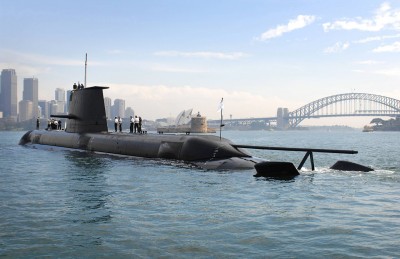Fantasies of the Fleet: The Emotion of Submarines

“Submarines are the spaceships of the ocean.”[1] Idiosyncratic as ever, the remark from Australia’s independent Senator John Madigan on the ABC program Q & A, who had seemingly come down from a distant historical shelf, says the needed thing when it comes to submarine fleets. Submarines are akin to extra-terrestrial vessels, moving through space. They are also the obsessive hallmarks of military establishments keen for a fictional presence in the deep ocean. To hell with the logistics – every state shall have its childish complexes.
Certainly, in the context of such countries as Australia, the presumption is that maritime powers need to have some submerged, naval deterrent. Britain continues to intrigue with its nostalgically pining idea of a nuclear-sea deterrent, with Trident becoming the unimpeachable weapon of politics, ever costly, ever draining. Abandon Trident, it seems, and you commit a form of treason, or at the very least, political suicide.
When Philip Hammond replaced Liam Fox as secretary of state for defence in October 2011, commentators were aflutter that the successor “may be less committed to renewal of the country’s nuclear deterrent than his predecessor” (Jane’s Defence Weekly, Oct 19, 2011). There was little to fear, with Hammond doing the customary reassuring rounds, and claiming that threats posed by Iran and North Korea somehow necessitated Britain’s continued need for Trident. The UK Ministry of Defence and partners have now gone for over two years in their efforts in delivering a new generation of ballistic missile submarine (SSBN) class submarines, though the first is only scheduled to appear in costly majesty in 2028.
Like all deterrents, there are usually emotional yard sticks rather than genuine statements, and almost always irrelevant. But the submarine entices and excites, a weapon that gives the scantiest of illusions about security. “And when we talk about the subs,” exclaimed Madigan, “it absolutely bloody well astounds me that the rest of the world, our major competitors like Japan and Germany, these countries have been building submarines for over a hundred years.”
And not just those powers. The fantasy of security at sea, bought with expansive submarine fleets, risks creating another distracting, and ultimately dooming arms race. New Delhi, to give one notable example, is pushing for nuclear-armed submarines, with the INS Arihant scheduled to come into service this year. China is already bristling in that department, with US Vice Admiral Joseph Mulloy suggesting that it has outpaced the US in terms of raw numbers.[2]
The Australian Defence Force Chief Mark Binskin is certainly unconvinced about any need for such a new fleet, which will cost in the order of $20 to $30 billion, though he does concede to its emotive potential. “I don’t believe you have to build [submarines] to be able to sustain in the country.” The Abbott government has been squirming over the process of how, exactly, the submarines will be built, be it offshore or actually in Australia itself. No formal tender process has been suggested – instead, a “competitive evaluation process” is on the cards, which is bound to involve neither competition or evaluation.
In the spirit of jingoism, Prime Minister Tony Abbott has made it clear that an openly competitive process might lead to the sneaky Russians getting a bite of the submarine market. “An open tender is there for anyone and the last thing we would want to see is a Russian company, for argument’s sake, bidding to produce an Australian submarine” (AAP, Feb 11). Fears, perhaps, that it just might work.
The government has, in turn, attacked their opposite numbers for wanting submarines from Russia or, in a rather stretched manner, Korea. “What the leader of the Opposition wants, he wants anyone to be able to compete to provide Australia’s next generation submarines. He might want the Russians to compete. The Putin class subs.” As for North Korea, an open tender might well give Australia “Kim Jong-il submarines.”
Across the political aisle, opposition leader Bill Shorten has been happily dumping on the Japanese, whom he cannot stand coming into contention as a possible builder of Australian submarines. “In the Second World War, 366 merchant ships were sunk off Australia and the government in the 1930s said ‘we don’t need Australian ships, we’ll privatise them.” This, argues Abbott, demonstrates a form of “antediluvian xenophobia”.
Both sides of politics, in other words, have their foreign monsters, engineers and designers who just won’t, for some far-fetched historical reason, be considered. Not only is the construction issue a vapidly patriotic one; it is steeped with competitive idiocy.
All in all, the question to be asked is how a fleet of 12 costly, overbearingly unproductive submarines could make a difference in the Asia-Pacific, other than wounding the budget. Maritime power is, as defined by the British Ministry of Defence, “The ability to project power at sea and from the sea to influence the behaviour of people or the course of events.”[3] The British rationale for exercising maritime power is bound up in its past as a naval power, wedded, as well, to the idea that “prosperity, stability and security depend upon the vital access provided by the sea and the maintenance of an international system and free trade.” That too, has its inventory of illusions.
The Australian variant of this vision, however, is hard to fathom. It intends introducing the equivalent of air rifles before howitzers. For the US cheerleaders such as Greg Sheridan of The Australian (Feb 21), the presence of a new submarine fleet is necessary to “balance” the arms race in the region. How that balance is measured is impossible to say, though certainty is never far from those who have invested in deterrence the properties of clarity and reality. Perhaps they are spaceships of the ocean after all.
Dr. Binoy Kampmark was a Commonwealth Scholar at Selwyn College, Cambridge. He lectures at RMIT University, Melbourne. Email: [email protected]
Notes:
[1] http://junkee.com/submarines-are-the-spaceships-of-the-ocean-and-other-things-we-learned-from-last-nights-qanda/50246
[2] http://rt.com/news/235651-china-us-submarine-fleet/
[3] https://www.gov.uk/government/uploads/system/uploads/attachment_data/file/33699/20110816JDP0_10_BMD.pdf

